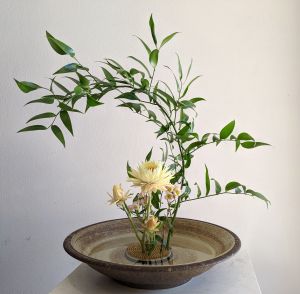Difference between revisions of "Flower-Arrangement"
Jump to navigation
Jump to search
(Created page with " Flower-Arrangement ; In Japanese, Ikebana As great lovers of nature, the Japanese try to create miniature editions, as in their gardens, built of s...") |
|||
| (One intermediate revision by the same user not shown) | |||
| Line 1: | Line 1: | ||
| + | [[File:1 EVDoF37CfggPKnKY9jylQQ.jpg|thumb]] | ||
| + | [[Flower-Arrangement]] ; In [[Japanese]], [[Ikebana]] As great lovers of [[nature]], the [[Japanese]] try to create miniature editions, as in their [[gardens]], built of stones, [[trees]] and [[water]]; or stunted [[trees]] in small containers, and in [[flower]] arrangement so stylized that each [[symbolizes]] a message, frequently a Bst. message. [[Ikebana]], | ||
| − | [[ | + | like [[Cha-no-yu]] (q.v.) was born in the [[Silver Pavilion]] (q.v.) near {{Wiki|Kyoto}} built in fifteenth century. |
| + | |||
| + | Leading exponent in [[England]], [[Miss Stella Coe]], a qualified [[master]] of the [[art]]. | ||
| − | + | See [[Gustie Herrigel]], [[Zen in the Art of Flower Arrangement]] (1958). | |
| − | |||
| Line 12: | Line 15: | ||
{{R}} | {{R}} | ||
| − | [[Category:]] | + | [[Category:Japan]] |
Latest revision as of 06:32, 13 December 2020
Flower-Arrangement ; In Japanese, Ikebana As great lovers of nature, the Japanese try to create miniature editions, as in their gardens, built of stones, trees and water; or stunted trees in small containers, and in flower arrangement so stylized that each symbolizes a message, frequently a Bst. message. Ikebana,
like Cha-no-yu (q.v.) was born in the Silver Pavilion (q.v.) near Kyoto built in fifteenth century.
Leading exponent in England, Miss Stella Coe, a qualified master of the art.
See Gustie Herrigel, Zen in the Art of Flower Arrangement (1958).
